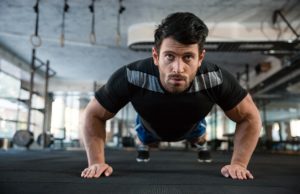 A number of patients have come to us recently because they are experiencing pain in their wrists when they do push-ups. Push-ups are a good way of strengthening the upper body, but they put a lot of pressure and strain on the wrists. The push-up position results in extreme extension and compression of the joints in the wrist. This puts pressure on the support structures including the bones, ligaments, tendons and cartilage. Unlike the ankles and feet the wrists and hands are not designed and often not conditioned for weightbearing.
A number of patients have come to us recently because they are experiencing pain in their wrists when they do push-ups. Push-ups are a good way of strengthening the upper body, but they put a lot of pressure and strain on the wrists. The push-up position results in extreme extension and compression of the joints in the wrist. This puts pressure on the support structures including the bones, ligaments, tendons and cartilage. Unlike the ankles and feet the wrists and hands are not designed and often not conditioned for weightbearing.
A number of conditions can cause pain in your wrist when you do push-ups.
1. Carpal Tunnel Syndrome
Carpal Tunnel Syndrome causes pain on the thumb side of the wrist and hand due to compression of the median nerve as it passes through the wrist. The nerve passes through a narrow space in the wrist and the push-up position narrows this space even further. If this is the problem, you may also experience pins and needles in the thumb side of the wrist, palm and first three fingers. You may also feel some weakness in the hand.
2. Tendosynovitis
Tendons join the muscles of the forearm to bones in the hand. They also pass through a narrow space on their way into the hand. This narrowing can cause rubbing of the tendons, which causes pain and swelling. This is especially likely to happen if the muscles are tight or too weak for what you are trying to get them to do. The tendons on the thumb side of the wrist are most often effected and this is called DeQuervains Tenosynovitis.
3. Wrist Sprain
A wrist sprain occurs when the ligaments (which join bone to bone) are pulled or even torn. A sprained wrist usually occurs with a sudden injury such as a fall or forceful twist or pull on the hand. Less commonly it can occur gradually if the wrist is held in an extreme position for a long period of time. So the push-up position can be the actual cause of the sprain and therefore pain, or it may be painful due to a previous injury. The push-up position stretches the ligaments on the palm side of the wrist and compresses those on the back of the wrist.
4. Ganglion
A ganglion is a fluid-filled pocket in the capsule that surrounds a joint. There are eight little bones that make up the wrist and if they rub together enough then a ganglion can form. They are most common on the back of the wrist and if big enough, look like a round lump when you drop your wrist down. The push-up position compresses the back of the wrist so will make a ganglion painful or can even cause a ganglion to form. Ganglions in themselves are harmless but any wrist position that compresses the ganglion may be painful. They can be drained if they are causing a lot of problems, but quite often recur.
5. Damage to the Triangular Fibrocartilage
There is a wedge of cartilage that sits in the little finger side of the wrist. It helps with shock absorption and the transfer of load in the wrist. If this cartilage is damaged – usually by a twisting force when there is weight through the wrist – then the push-up position will be painful. Dynamic push-ups – such as those with a clap in between or a drop onto the hands – can cause a tear in the cartilage. Once the cartilage is torn the wrist is unstable.
So, as you can see, there are a number of reasons why push-ups may be causing pain in your wrists. Your Physio will assess your wrist range of motion, strength and stability and work out which is causing your problem. They can then treat you with manual therapy and stretches and give you exercises to do to help strengthen the right muscles. They can also advise you on how best to do push-ups without straining the wrist joints.





